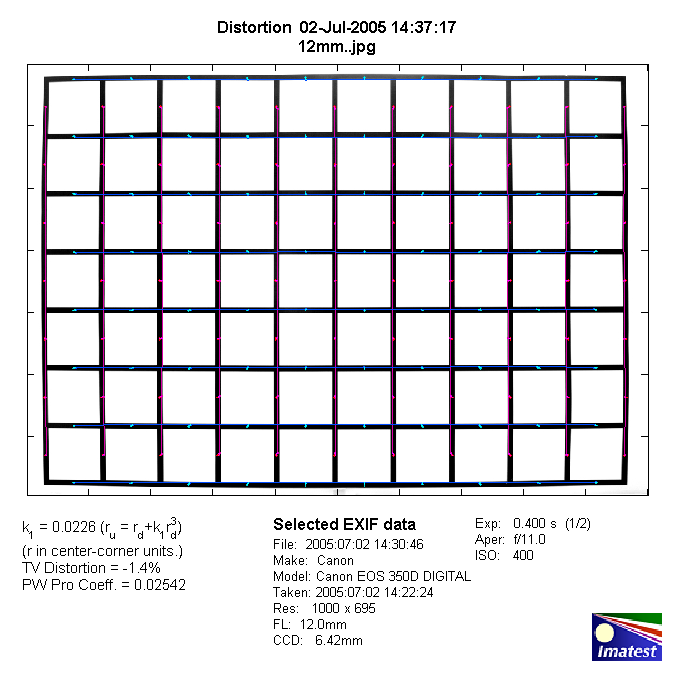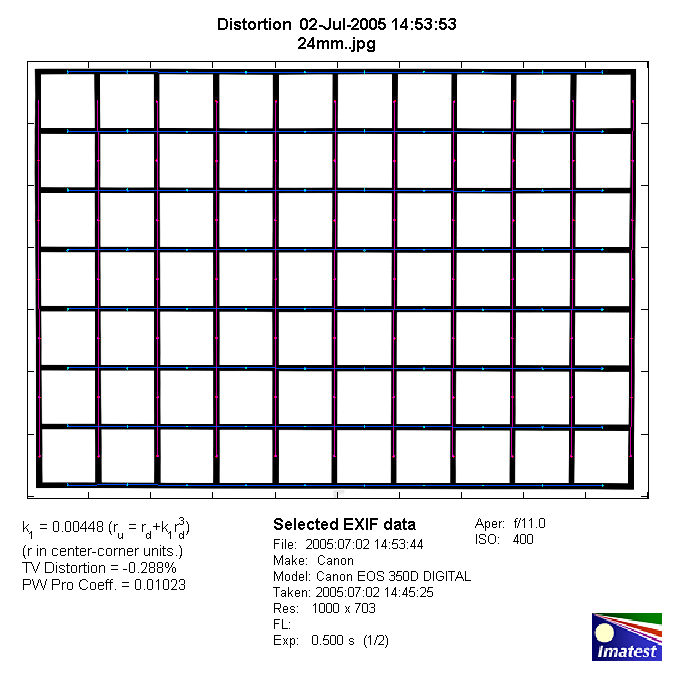|
Tokina AF 12-24mm f/4 AT-X Pro DX (Canon) - Review / Test Report - Analysis |
|
Lens Reviews -
Canon EOS (APS-C)
|
|
Page 2 of 3
Distortion
In absolute terms there is quite a bit of wavy barrel distortion (1.4%) at 12mm.
If you've straight lines in your image this distortion may be noticeable. However,
within the class of ultra-wide zooms this value can be considered as quite low.
At 24mm there is no significant distortion anymore (0.28%) though the grid remains
a little wavy.
12mm:

24mm:

The chart above has a real-world size of about 120x80cm. Possibly expect more distortion towards closer focus distances.
Vignetting
Regarding the ultra-wide character of the lens vignetting was a little hard to measure so take
the chart below as a rough guidance only.
At 12mm @ f/4 the lens shows noticeable vignetting (~1EV) which will be visible in some scenes - it's
still a quite decent value for an APS-C ultra-wide lens. At f/5.6 the problem is already largely reduced
(~0.6 EV). At 18mm and 24mm there's moderate vignetting at large aperture.
One stop down vignetting is already quite negligible here.

MTF (resolution)
The Tokina was a little difficult to test regarding resolution due to a rather extreme
degree of chromatic aberrations (see next chapter) which interfered to some degree with
the MTF analysis of the data. Nonetheless the lens was capable to deliver highly
impressive results. At 12mm the center performance is excellent straight from
f/4. Typical for most ultra-wides the borders can't quite follow but from f/5.6 & up
the borders are very-good and the extreme corners follow closely. At 18mm and
24mm the center performance is slightly worse (but still excellent) but with
generally improved borders.
Please note that the MTF results are not directly comparable across the different systems!
Below is a simplified summary of the formal findings. The chart shows line widths per picture height (LW/PH) which can be taken as a measure for sharpness.
If you want to know more about the MTF50 figures you may check out the corresponding Imatest Explanations
Chromatic Aberrations (CAs)
The primary weaknesses of this lens are chromatic aberrations (visible as color shadows at harsh
contrast transitions). The CAs remain well beyond 1 pixel in width on the average at the borders at all
focals lengths. The peak is at 12mm f/4 with a max. of 2.5 pixels. This is the most extreme degree
of CAs measured to date.

CAs are no principal killer criteria because they can easily be corrected via various tools such as the Adobe
Photoshop RAW converter or Debarrelizer (a Photoshop plug-in). Here's an example of the problem and how easily
it can be corrected:

|